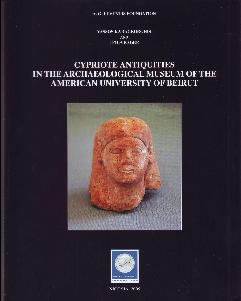Description
In 1866 an American high institution of learning was created in Lebanon, which was then called the Syrian Protestant College and later became the American University of Beirut. Many Cypriots studied at this University. The Archaeological Museum of the University was created in 1868 and received its first acquisitions as gifts from Luigi Palma di Cesnola, the well known American Consul to Cyprus, who took office in 1865 and already the following year started his first “exavations” in the island (1866-1869). This gift created the nucleus of the Archaeological Museum of the American University (AUB), which became the third oldest museum in the Near East. The same happened, as we know, but on a much larger scale, with the Metropolitan Museum in New York, which was created after the sale of the Cesnola Collection to the city of New York in 1873.
In 2006 the very energetic Director of the Museum Dr. Leila Badre renovated the exhibition galleries of the Museum, which contain antiquities that came to light as a result of the Museum’s excavations in Lebanon, but also others, which were donated by Libanese or were purchased from antiquities dealers in Beirut. The Leventis Foundation assisted the efforts of the Director for the refurbishment of the Museum by covering the cost for the construction of a large exhibition case for the majority of its Cypriote antiquities. It is today a very rich museum, which contributes significantly towards the archaeological research in the region. The new exhibition, satisfying the most modern requirements of museology, constitutes a prototype for other museums of the Near East, providing ample didactic material which facilitates enormously the teaching of Archaeology at the University.
The Cypriote collection of the Museum comprises 178 items. We mention in particular a substantial number of vases which were brought to light in 1958 by the then Professor of Archaeology at the AUB Dimitri Baramki, who excavated a chamber tomb of the Late Bronze Age at Sarepta (South Lebanon).
A number of limestone sculptures of Cypriote type, now in the Museum, were probably found in Lebanon and/ or Syria, where the ancient Cypriots, as we know, used to export Cypriote sculptures of different sizes, which were placed as votive offerings in, for example, the sanctuary of Eshmun in Sidon and the sanctuary of Heracles – Melcart at Amrit (Syria). Most of them are today exhibited in the Archaeological Museum of Constantinople, where they were transported by the excavator of Sidon Macridy Bey to the archaeological museum of the then capital of the Ottoman Empire. A few of them, excavated later by French archaeologists, are today exhibited in the National Archaeological Museum of Beirut which has recently been refurbished, after the damage which it suffered during the civil war in Lebanon.
Cyprus had close commercial relations with the region of present-day Lebanon, as early as the 18th century B.C., particularly with the large harbour towns of Sidon, Tyre and Byblos. Recent excavations at Sidon, which are still going on, have brought to light important material which illustrates these relations. Contacts between Cyprus and Lebanon became even closer during the first half of the first millennium B.C., when the Phoenicians started their expansion westwards; the first coast where they landed and founded commercial colonies was Cyprus, namely Kition and Amathus. It is in fact this region of Cyprus which received the Lebanese refugees during the recent civil war in Lebanon.
The publication of Cypriote antiquities in the Archaeological Museum of the American University of Beirut, falls within the framework of the ambitious project of the A. G. Leventis Foundation to make known all the main collections of Cypriote antiquities in the main museums of the world. Though the collections of the Museum of AUB are not as important as those of the large museums of Europe and America, they are not at all insignificant. The study of the ceramics of the Museum, for example, brought to light a substantial number of vases of the Late Bronze Age, of Cypriote type, imitated by local potters in antiquity. We observe the same phenomenon in other parts of the Mediterranean, as for example in Rhodes, Crete and Sicily.
The richly illustrated catalogue of Cypriote antiquities in the Archaeological Museum of the AUB, recently published for the A. G. Leventis Foundation by V. Karageorghis and Leila Badre, comprises 141 items, namely sculptures, ceramics and terracottas. It will be an important tool for University students of archaeology at AUB, but also for other visitors of the Museum and all other researchers of ancient Cypriote art.








